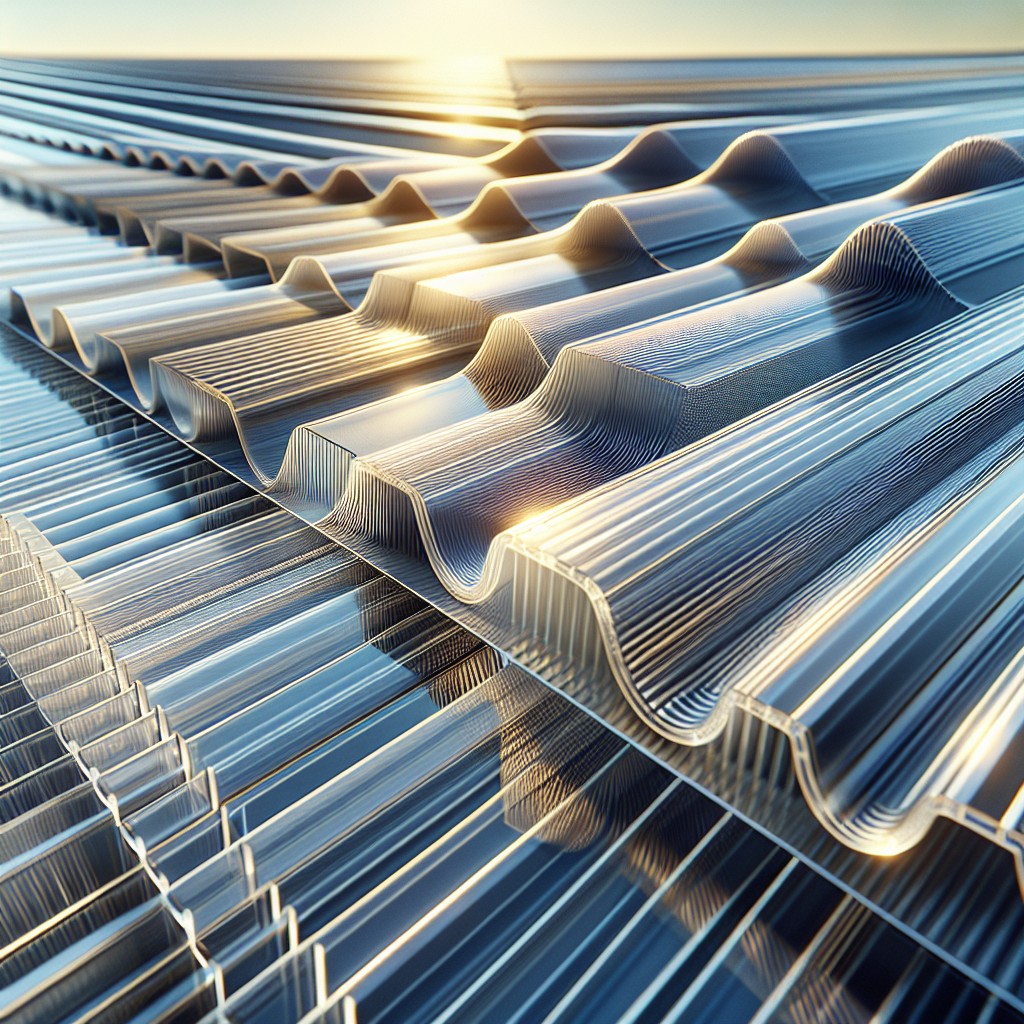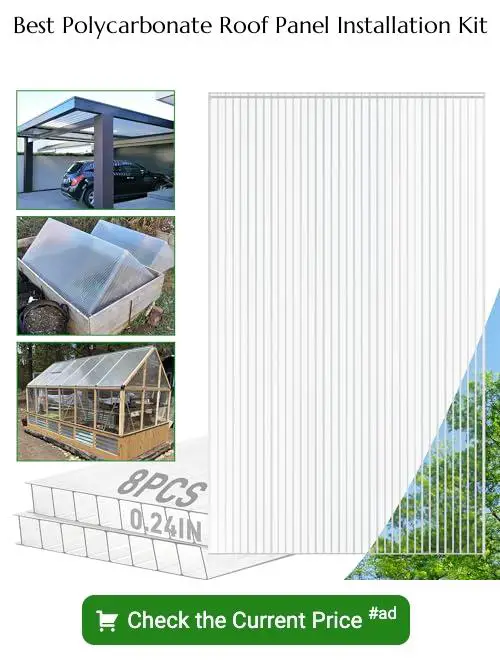Last updated on
Polycarbonate roof panels are gaining popularity in modern architecture because they offer unparalleled strength, clarity, and durability.
Polycarbonate roof panels are rapidly becoming the material of choice for a myriad of projects, striking the perfect balance between durability and aesthetic versatility. With their unique ability to offer robust UV protection while maintaining lightness, they cater to a vast range of applications, from the sleek canopies of residential patios to the more demanding environments of industrial and agricultural structures.
Understanding the nuances of polycarbonate roofing—from selecting the right type and size to mastering installation techniques—is crucial for tapping into its full potential over traditional glass. This exploration will delve into the practical considerations and the distinct advantages of polycarbonate panels, ensuring you make an informed decision for your next roofing endeavor.
Key takeaways:
- Polycarbonate is lightweight yet strong and offers UV protection.
- Different types of polycarbonate panels for various applications and aesthetics.
- Polycarbonate roofing is suitable for industrial, residential, and agricultural projects.
- Consider panel size, cutting, expansion, and overhang for proper installation.
- Polycarbonate roofing offers advantages over glass, including durability and cost-effectiveness.
What Is Polycarbonate Sheet?

Polycarbonate is a thermoplastic polymer that’s notably lightweight yet strong and impact-resistant, making it an outstanding alternative for roofing panels. Its transparency can rival that of glass, allowing for excellent light transmission while providing UV protection due to its naturally filtering properties.
This material can be manufactured in a range of thickness levels, colors, and treatments that enhance its durability and suitability for various applications. Moreover, its versatility allows it to be easily shaped and molded at high temperatures, then cooled to retain the new form, adding to the design flexibility for roofing projects.
Polycarbonate panels are also known for their insulation capabilities which can contribute to energy efficiency in buildings.
Types Of Polycarbonate Roofing Panel

Polycarbonate roofing panels come in various types, each suited for different applications and preferences.
- Corrugated: Ideal for roofing projects that require flexibility and a hint of a traditional look. They are light and strong, with a wave-like design that channels water effectively.
- Twin-wall: These panels consist of two layers separated by an internal ribbing structure, providing excellent insulation. Suitable for environments that demand temperature regulation.
- Triple-wall: An upgrade from twin-wall panels, they contain three layers and provide even better insulation and impact resistance, often used in harsher climates or where extra sturdiness is paramount.
- Solid polycarbonate: More akin to glass in appearance, these panels are clear and offer a blend of high impact resistance with a sleek finish, making them popular for modern designs.
- Multiwall: They encapsulate multiple layers, akin to the twin or triple-wall designs, but offer increased thickness, strength, and insulation, often used for commercial structures.
- Textured or frosted: These are designed to diffuse light and offer privacy while still allowing natural light to permeate the space, frequently used in decorative scenarios or where direct sunlight might be overwhelming.
Each type contributes different aesthetic and functional characteristics to a roofing system, ensuring that there is a polycarbonate solution for nearly every roofing need.
Usage Of Polycarbonate Roofing
Polycarbonate roofing offers a range of applications due to its versatility and durability. It is commonly found in industrial settings for skylights and roof lights, enabling natural light to permeate large spaces without compromising on strength. Residentially, it’s ideal for conservatories, patios, and deck areas as it offers protection against UV rays while maintaining a light and airy atmosphere.
In agricultural contexts, polycarbonate panels are favored for constructing greenhouses. Their ability to withstand tough weather conditions, coupled with excellent light transmission properties, creates an optimal environment for plant growth. Moreover, due to their lightweight nature, they are also suitable for DIY projects, such as sheds or carports, where ease of installation is a benefit.
In architecturally ambitious projects, these panels can be employed for creating elegant and modern facades or roofing systems that allow for creative expression without the expense and fragility of glass. Additionally, for sports venues, where safety is paramount, the impact resistance of polycarbonate roofing ensures protection for both spectators and athletes.
Proper Size For Your Roofing
Selecting the appropriate dimensions for polycarbonate roofing panels is critical to ensure they meet the project’s structural requirements and aesthetic goals. When determining the proper size, consider the following points:
1. Panel Width: Match the width to the roof’s rafter or purlin spacing to support the panel adequately and avoid sagging.
2. Length: Panels should run the full length of the roof from ridge to eave, reducing the need for horizontal seams which can be potential leak points.
3. Thickness: Thicker panels generally offer better insulation and durability. Common thicknesses range from 4mm for light-duty applications up to 25mm for commercial projects.
4. Expansion Allowance: Polycarbonate expands when heated and contracts when cooled. Always leave a small gap at the edges to accommodate this movement.
5. Cutting: If custom sizes are needed, panels can be cut using fine-tooth saws or sharp blades; measure and mark carefully to ensure straight, clean edges.
6. Overhang: Ensure a sufficient overhang beyond the roof’s edge to allow for proper water runoff, typically between 50mm to 75mm.
By taking into account these points, you’ll ensure a proper fit that supports the longevity and effectiveness of your polycarbonate roofing.
How To Install Polycarbonate
Begin with measuring the roof to determine how many panels are needed, allowing for an overlap of at least one ridge when laying them side by side. Trim the polycarbonate sheets to the required size, using a fine-toothed saw or a pair of heavy-duty scissors for the task.
Prior to installation, remove the protective film from the sheets and attach the panels to the roof structure with screws. Use special polycarbonate roofing screws that come with a waterproof washer to prevent leaks. Ensure you drive the screws straight to avoid damaging the panels.
Install the panels starting from one side of the roof and working across. Overlap each panel by at least one ridge if using corrugated sheets, or follow manufacturer recommendations for multiwall sheets. For better water resistance, consider sealing the overlap with silicone caulk.
Support the panels along their length using purlins, spacing them as per the manufacturer’s instructions. The purlins not only provide support but also help maintain the roof’s integrity during temperature changes.
Always pre-drill holes for the screws slightly larger than the screw diameter to allow for the expansion and contraction of the polycarbonate material. This is critical, as failing to account for thermal movement can result in buckling, warping, or cracking of the panels.
For finishing touches, install U-profiles at the lower end of the panels to keep out dirt and insects, and F-profiles on the adjoining edges to connect panels aesthetically. If using multiwall sheets, sealing tape should be applied to the top end to prevent moisture ingress.
When working on the roof, walk with care to avoid cracking the polycarbonate. Use crawl boards spread across at least two purlins to distribute your weight evenly. Exercise caution with power tools and ensure personal safety by using the appropriate protective equipment.
Remember to follow all manufacturer installation guidelines closely to ensure a secure and long-lasting roof.
Why You Should Choose Polycarbonate Roofing Over Glass?
Opting for polycarbonate panels rather than glass offers several practical advantages. These lightweight sheets are easier to handle and install, reducing labor intensity and installation time. Their resilience is notable; they are virtually unbreakable and can withstand significant impact without shattering, a vital safety feature in areas prone to severe weather events or where accidental impacts are a concern.
Moreover, polycarbonate provides superior insulation compared to glass, contributing to better temperature regulation within the structure. The UV-resistant coatings often applied to polycarbonate roofing also add a layer of protection against sun damage, further elongating the lifespan of the structure.
In terms of design versatility, polycarbonate panels come in a range of colors and transparencies, allowing for creative light diffusion and aesthetic options not easily achieved with traditional glass. Cost-effectiveness is another key point, with polycarbonate typically being more affordable than glass, both in initial expenditure and long-term maintenance.
In summary, the durability, safety features, thermal efficiency, design flexibility, and cost benefits make polycarbonate an advantageous selection over glass for roofing projects.
Acrylic VS Polycarbonate
Acrylic and polycarbonate are two popular materials used for transparent roofing panels, each with distinct properties that may make one more suitable than the other depending on the application.
Acrylic panels are known for their exceptional clarity and resistance to UV light, remaining clear over time without yellowing. They offer a glass-like aesthetic and are more scratch-resistant than polycarbonate. This makes acrylic a good choice for projects where appearance is key and where the material is not likely to encounter severe impact.
Polycarbonate, on the other hand, touts its high impact resistance as its main advantage. It’s the material of choice for areas prone to hail, falling debris, or other impacts. Although less scratch-resistant than acrylic, polycarbonate’s strength means it is less likely to crack or shatter upon impact. Its ductility allows it to be shaped at room temperature without cracking, catering to creative roofing designs.
While both materials can be used for roofing, selecting between acrylic and polycarbonate will hinge on the specific needs of your project – aesthetic appeal versus impact resistance and shaping capabilities.
Polycarbonate Roofing For Greenhouse
The translucent nature of polycarbonate panels makes them ideal for optimizing sunlight exposure in a greenhouse setting. These panels permit natural light to penetrate while providing insulation, crucial for maintaining steady temperatures for plant growth.
They also offer a resilience that can withstand impacts like hail, a common concern for greenhouse operators. When considering polycarbonate for a greenhouse, factor in UV protection, as quality sheets are treated to block harmful ultraviolet rays while still allowing for maximum light transmission.
The lightweight property of these panels simplifies the installation process and poses less structural stress compared to heavier materials. Furthermore, polycarbonate can easily be cut to fit custom shapes, ensuring a snug fit for any greenhouse design.
With proper care, such as regular cleaning with mild detergents, polycarbonate roofing can last for years, making it a sustainable option for long-term horticultural projects.
Advantages And Disadvantages Of Polycarbonate Roofing
Polycarbonate roofing offers a host of benefits that make it an attractive choice for many projects. Its lightweight nature ensures easy handling and installation, reducing labor costs and structural requirements. Known for their impact resistance, polycarbonate panels stand up well to hail, falling branches, and other similar threats, surpassing the durability of materials like acrylic or glass. With a natural transparency that can rival glass, polycarbonate allows for excellent light transmission, making it ideal for applications requiring natural light.
Another significant advantage is the material’s inherent flexibility, which allows it to be bent or shaped to suit various architectural designs without cracking or breaking.
On the downside, polycarbonate panels can be susceptible to scratches and may require UV-stabilizing coatings to prevent long-term sun damage. Over time, exposure to the elements can lead to discoloration, reducing the aesthetic appeal of the roof. Additionally, while polycarbonate is more thermally efficient than glass, it may not provide as much insulation as other roofing options, potentially leading to higher energy costs to maintain temperatures inside the structure. Installation must be meticulously done to avoid errors that can compromise the roof’s integrity, like leaving gaps that could invite leaks or allowing for thermal expansion.
Choosing polycarbonate roofing requires a careful consideration of these factors to ensure it aligns with the specific needs and longevity expectations of your project.
Choosing Between Corrugated And Multiwall Sheets
When deciding between corrugated and multiwall polycarbonate sheets, consider these points:
1. Purpose: Multiwall sheets are excellent for thermal insulation, making them ideal for climates with temperature extremes, while corrugated options, with their simpler structure, are often used in projects where insulation is less of a concern.
2. Aesthetics: The structured look of multiwall sheets provides a sleek, modern appearance. Corrugated sheets offer a more traditional, ribbed appearance that may blend well with certain architectural styles.
3. Durability: Multiwall sheets tend to be more durable against impacts due to their layered construction, which also allows for better load-bearing capacity.
4. Light Transmission and Diffusion: Multiwall panels usually provide better light diffusion, leading to a more even distribution of light which is beneficial for applications like greenhouses, while corrugated sheets might allow more direct light through.
5. Installation: Corrugated sheets are typically easier and faster to install due to their lighter weight and less complex structure, which can be a deciding factor for DIY projects.
6. Budget: Corrugated sheets generally come with a lower price tag compared to multiwall sheets.
Choosing the right type depends on your project’s specific needs in terms of insulation, strength, light management, aesthetics, ease of installation, and budget. Consider these factors carefully to ensure you select the best option for your roofing project.
How To Take Care of Polycarbonate Sheets
Maintaining the clarity and durability of your polycarbonate sheets ensures they last longer and continue to perform effortlessly. Firstly, regular cleaning with mild soap and lukewarm water will prevent the accumulation of dirt and grime that can cause scratches. Use a soft cloth or sponge for this task to avoid abrasive damage.
When deeper cleaning is necessary, a solution of isopropyl alcohol and water can be utilized to tackle more stubborn stains. Rin’t use abrasive cleaners as they can scratch the surface of the polycarbonate, compromising its appearance and integrity.
During cleaning, avoid using squeegees or harsh brushes which can leave marks. After washing, rinse the sheets thoroughly with clean water to prevent soap residue build-up, which can create a cloudy appearance over time.
Inspect your polycarbonate roofing regularly for scratches or impact damage. Although polycarbonate is impact resistant, severe impacts can still cause dents or distortions. In cases of damage, consult with a professional for repair or replacement options.
Furthermore, keep in mind that protective film on new sheets should be removed immediately after installation to prevent the film from baking onto the panel surface due to sunlight exposure, which can make it difficult to remove later and potentially damage the sheet.
Lastly, when performing maintenance around the roof area, such as cleaning gutters or removing branches, be cautious to not lean ladders or heavy tools against the polycarbonate, as excessive pressure or weight can cause cracking or bending. With these caretaking practices, your polycarbonate sheets will maintain their aesthetic appeal and functional benefits for years to come.
FAQ
What are the disadvantages of polycarbonate roofing?
Polycarbonate roofing, despite its merits, has notable disadvantages such as requiring special cleaning solutions for maintenance, and susceptibility to damage and reduced longevity with each cleaning due to the abrasive nature of the cleaning tools.
How long do polycarbonate roof panels last?
Polycarbonate roof panels typically have an average lifespan of 10 to 20 years, though with proper care, they can last even longer.
Is polycarbonate roofing worth it?
Yes, polycarbonate roofing is worth it due to its superior strength and impact resistance, making it an excellent choice for outdoor structures.
What thickness solid polycarbonate should I use for roof?
The recommended thickness for solid polycarbonate roofing sheets is between 3 to 6mm.
How does weather affect the durability of polycarbonate roofing?
Weather conditions, particularly extreme temperature fluctuations, UV radiation, heavy rains, and high winds, can degrade the durability and longevity of polycarbonate roofing over time.
Can polycarbonate roof panels withstand hail or heavy snowfalls?
Yes, polycarbonate roof panels are highly resilient and able to withstand hail or heavy snowfalls due to their exceptional impact resistance and load-bearing capabilities.
What maintenance requirements do polycarbonate roof panels have?
Polycarbonate roof panels require periodic cleaning with mild soap and water, along with a visual inspection for damage, to maintain their functionality and longevity.





